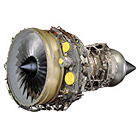 The Cockpit Conversation blog has posted an interesting and darkly amusing tale about engines being “vulnerable to idiots” and the consequences of this. In 2004, two Pinnacle Airlines pilots were flying without any passengers and decided to “have some fun” with their CRJ200 and fly it to its published performance ceiling of 41,000 feet.
The Cockpit Conversation blog has posted an interesting and darkly amusing tale about engines being “vulnerable to idiots” and the consequences of this. In 2004, two Pinnacle Airlines pilots were flying without any passengers and decided to “have some fun” with their CRJ200 and fly it to its published performance ceiling of 41,000 feet.
To make a long story short, the aircraft was completely destroyed in the ensuing crash and both pilots were killed – earning them a nomination for a “Darwin Award” (more specific details along with links to the NTSB report and the cockpit voice recording transcript are available on Cockpit Conversation).
However, the story does not end there. According to Cockpit Conversation:
The families of the pilots sued the engine manufacturer for not making it clearer that if you did unspeakably stupid things with their engines, they were unlikely to continue functioning. And now the FAA has mandated changes to the General Electric CF34 turbofan engine based on this crash.
The FAA have concluded that “excessive” friction between the static and rotating portions of a certain engine seal, under certain high-power, high-altitude conditions is unsafe and must be corrected. This is a mandatory airworthiness directive, so over two thousand such engines will have to undergo a modification, costing their operators ten hours per airplane.
Obviously engines and airplanes are NEVER meant to be flight tested by pilots to their published performance level. However, the FAA decision is equally unfortunate for general aviation; after all, the manufacturing of general aviation aircraft nearly ended in the 1980s due to the threat of lawsuits.
Let us hope that such incidents and legal decisions across the pond AREN’T repeated as they have consequences for all.
You should do a search for the transcripts. I hate to dole out judgement on the deceased, but this flight had disaster written all over it from the start. And it was all 100% preventable by following normal procedures.